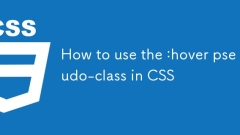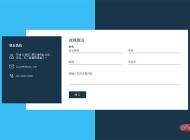current location:Home > Technical Articles > Daily Programming > CSS Knowledge
- Direction:
- All web3.0 Backend Development Web Front-end Database Operation and Maintenance Development Tools PHP Framework Daily Programming WeChat Applet Common Problem Other Tech CMS Tutorial Java System Tutorial Computer Tutorials Hardware Tutorial Mobile Tutorial Software Tutorial Mobile Game Tutorial
- Classify:
- PHP tutorial MySQL Tutorial HTML Tutorial CSS Tutorial
-

- How to create an accordion with CSS
- Use CSS to create an accordion effect without JavaScript, and it is combined with hidden checkbox or radio buttons: checked pseudo-class and sibling selector; 2. The HTML structure contains input, label and content div, type="checkbox" allows multiple expansions, type="radio" only allows single expansion; 3. The input is hidden in CSS, and the label is styled as a clickable title. Use the ~ selector to change the max-height of the adjacent .accordion-content when selected to achieve expansion animation; 4.max-height
- CSS Tutorial . Web Front-end 948 2025-08-30 09:21:01
-

- How to horizontally align an element in CSS
- Use margin:0auto to center horizontally with a block-level element with a fixed or maximum width, requiring the element to be block-level and has a clear width, without floating or absolute positioning; 2. Use Flexbox's justify-content:center to flexibly center direct child elements in the container without fixed width, suitable for modern layout; 3. Use CSSGrid's justify-items:center or place-items:center to realize horizontal centering of grid items, suitable for scenarios where Grid layout has been used; 4. Use text-align:center to center in row or in row block elements, which are often used for text, icons, buttons, etc., and need to act on the parent
- CSS Tutorial . Web Front-end 633 2025-08-30 09:07:01
-

- How to create a peel-off corner effect with CSS
- To create a stripping angle effect, use pseudo-element and CSS transformation; 2. The basic structure is a div with class name, and create a stripping angle through ::after pseudo-element; 3. Use linear-gradient to simulate light and shadow, transform to achieve tilt and displacement, z-index is placed at the bottom, box-shadow enhances three-dimensionality; 4. You can add:hover state to improve interactivity; 5. Pay attention to color matching, shadow direction and moderate tilt to enhance the sense of reality. This effect achieves a realistic corner peeling visual effect through pure CSS, and is suitable for elements such as buttons and cards.
- CSS Tutorial . Web Front-end 708 2025-08-30 08:35:01
-

- How to use the text-transform property in CSS
- none: Keep the text as it is, used to override inherited styles; 2.uppercase: convert text to uppercase, suitable for titles or buttons; 3.lowercase: convert text to lowercase, helping to normalize content; 4.capitalize: The first letter of each word is capitalized, often used for titles or names; this property only visually changes the text, does not affect the actual content and accessibility, and is safely available in all modern browsers.
- CSS Tutorial . Web Front-end 759 2025-08-30 08:25:01
-

- How to create a custom cursor image with CSS
- Yes,youcanreplacethedefaultcursorwithacustomimageusingtheCSScursorpropertybyspecifyingaURLtotheimagefollowedbyafallbackcursor,suchaspointerorauto,ensuringcompatibilityacrossbrowsersandprovidingvisualfeedbackorbranding,withconsiderationsforimageformat
- CSS Tutorial . Web Front-end 189 2025-08-30 08:24:02
-

- How to create a text reveal animation on scroll with CSS?
- Creating scrolling text display animations is limited only because CSS cannot detect scroll position; 2. It can be implemented through CSS with a small amount of JavaScript, and using mask-position or clip-path to control text display; 3. JavaScript monitors page scrolling through getBoundingClientRect or IntersectionObserver, and adds "revealed" class to trigger animation when elements enter the viewport; 4. It is recommended to use IntersectionObserver to improve performance and avoid frequent monitoring of scroll events; 5. Pure CSS solutions can only be used through anima
- CSS Tutorial . Web Front-end 151 2025-08-30 06:21:01
-

- How to create a tooltip in CSS
- To create a pure CSS prompt box, you need to use HTML structure combined with CSS styles to implement it; 1. Create an HTML structure containing trigger elements and prompt text; 2. Set relative positioning for the container and define the trigger style; 3. Set the prompt text to absolute positioning, initial visibility is hidden, and change it to visible through hover; 4. Use transition to achieve fading effect; 5. You can add pseudo-elements to create pointing arrows after; 6. Optimize position, width and accessibility to improve the experience, and ultimately realize a responsive prompt box without JavaScript.
- CSS Tutorial . Web Front-end 860 2025-08-30 05:42:02
-

- How to style a file input button in CSS
- Hide the file input box and use a custom label as a button. Set input[type="file"] to display:none through CSS, and then add button styles to the label to trigger file selection; 2. It is recommended to wrap input in the label to avoid ID conflicts and have a simpler structure; 3. You can listen to change events through JavaScript to display the selected file name to improve user experience; 4. You can further add icons or design advanced styles such as drag and drop upload areas; this method is compatible with mainstream browsers, ensure accessibility and achieve complete style control, and is the most reliable customization solution for file upload buttons.
- CSS Tutorial . Web Front-end 510 2025-08-30 04:08:01
-

- How to use the mix-blend-mode property in CSS
- mix-blend-mode controls the mixing method of the content of the element and the color of the behind element. 1. There must be a background (such as picture or color) to show the effect; 2. Commonly used values ??such as multiply and screen can achieve text hollowing or image superposition; 3. Pay attention to stacking context to avoid parent isolation:isolate from preventing mixing; 4. Avoid overuse in performance, especially in large elements or animations; 5. Modern browsers have good support, suitable for creating text effects, image filters, hover interactions and artistic layouts. It is recommended to get started with multiply and screen and combine high-contrast background to test the effect.
- CSS Tutorial . Web Front-end 885 2025-08-29 07:37:01
-

- How to create a two-column layout in CSS
- Use Flexbox or CSSGrid to create two-column layouts. 1. Flexbox implements the same width column by setting the container display:flex and child element flex:1. Different flex values ??can be used to control the width ratio and use gap to add spacing; 2. Grid defines two-level columns through display:grid and grid-template-columns:1fr1fr, which also supports gap and responsive adjustment; 3. In responsive scenarios, set flex-direction:column or grid-template-columns:1fr on the small screen through media query to make the columns stack vertically. Both methods are modern browsers
- CSS Tutorial . Web Front-end 589 2025-08-29 07:31:01
-

- How to create a fixed header in CSS
- Useposition:fixedontheheaderwithtop:0andwidth:100%topinittothetopoftheviewport.2.Applyz-index:1000toensuretheheaderstaysaboveothercontent.3.Addpadding-toptothebodyormaincontainerequaltotheheader’sheighttopreventcontentfrombeinghiddenbehindit.4.Ensure
- CSS Tutorial . Web Front-end 498 2025-08-29 06:48:01
-

- How to use the :hover pseudo-class in CSS
- :hover pseudo-class is used to apply styles when hovering. 1. The basic syntax is selector:hover{property:value;}, such as a:hover{color:red;}; 2. Common uses include changing colors, adding underscores, scaling elements, and displaying hidden content; 3. The best practice is to cooperate with transition to achieve smoothing effects, ensure accessibility, avoid over-dependence on the mobile side, and avoid abuse; 4. Advanced usage includes making one element's hover affect another element through a sibling selector, and nested hover effects for drop-down menus. Correct use: hover can improve interactivity, while paying attention to simplicity, accessibility and user experience.
- CSS Tutorial . Web Front-end 170 2025-08-29 05:44:01
-

- How to use the :in-range and :out-of-range pseudo-classes in CSS
- :in-range and :out-of-range are CSS pseudo-classes that are used to style form elements with min and max attributes based on whether the input value is within the specified range; 2. They are only suitable for input types that support range limitations, such as number, range, date, etc.; 3. When the input value is within the range, use:out-of-range when it is out of range, and use:out-of-range when it is out of range, and the style is dynamically updated in real time; 4. These pseudo-classes are independent of :valid or :invalid, but can be used in conjunction with them to enhance form feedback; 5. Error messages can be displayed in conjunction with: focus or adjacent selectors to improve user experience, and can be intuitively implemented without JavaScript.
- CSS Tutorial . Web Front-end 877 2025-08-29 05:19:02
-

- How to center an element with a fixed width in CSS
- Usemargin:0autotocenterafixed-widthblockelementhorizontally,whichworksreliablyacrossallbrowsersandrequiresonlytwoCSSproperties:afixedwidthandautomatichorizontalmargins.2.Forinlineorinline-blockelements,applytext-align:centerontheparentcontainertoachi
- CSS Tutorial . Web Front-end 774 2025-08-29 04:57:01
































